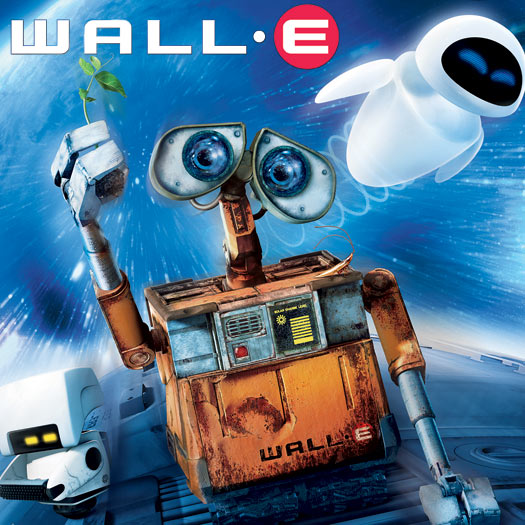I am remiss to admit that I did not feature a review for Pixar’s 9th wonderful feature film Wall·E when it came to theaters in June of this year. Not only do I find it one of the company’s most heartwarming pictures but I also consider it to be one of the best films of the year.
Fortunately, we have the DVD release to reflect on and take the time to fully absorb the brilliance that is Wall·E.
For the uninitiated, Wall·E is a small, boxy robot left on Earth to clean up the mess left behind by humanity as they have shuttled themselves off-world on the dime of the global corporation Buy N Large. Our Wall·E is one of many, but the only one left still functioning. Day in and day out he performs the tasks he was programed to do – scoop trash into his tiny frame, compact it into cubes and stack them into spirling skyscrapers. He does his work efficiently, with no complaints… and totally alone.
Centuries in isolation have caused Wall·E to develop a personality. Like a beachcomber, he collects odd trinkets in an attempt to understand the history of a society that has long since abandoned him. He collects spoons and forks, hubcaps and adoringly watches an old videotape of Hello, Dolly – longingly looking for companionship.
Companionship comes in the form of a sleek and elegant probe droid named EVE, sent to Earth to search for signs of plant life. What follows is an adventure that takes Wall·E off Earth and reconnecting with the remnants of humanity living on-board a luxury star cruiser before leading them home.
The commentary track from director Andrew Stanton reveals a lot. While he admit that the movie hits on themes of environmentalism, consumerism and some of the more slothful tendencies of humans coddled by technology, he never set out to make a “message” movie. Stanton identifies himself as the type of person who likes to keep his politics to himself and was not interested in preaching to the audience. The themes established in the film developed out of the “reverse engineering” of the film’s core concept – a robot left on Earth all by himself and what would that feel like?
Stanton’s commentary reveals a lot about Pixar’s film making process. They establish a simple premise and start asking questions.
“Okay, he’s a robot alone on Earth? What is he doing there? He’s cleaning up. He’s a janitor. Why? Because that seems like a lonely job to do. Why is he alone? Because humanity left Earth. Why? Rampant consumerism ruined the planet. Oh, so he’s cleaning up what they left behind? Yeah! Are there other robots helping him? There were, but the broke down. So then he must have been working for a very long time? Let’s say 700 years. But he doesn’t spend the entire movie by himself? How do we introduce conflict? A probe robot visits Earth. What’s it doing? Looking for plant life. Why? Because then humanity can come back to Earth.”
And so on and so on. I reveals a simple extrapolation process in the writing and gives you the impression that the film’s “message” was a lot less deliberate and serious than some people took it.
In addition to the movie, the three disc special edition contains bountiful extras well worth your time. Most stunning is a deleted scene introduced by Stanton that was pulled from the film in the 11th hour. It’s the trash compactor scene right before the third act where, instead of Wall·E being damaged, it’s EVE who is nearly beyond repair. As Stanton explains, the scene was in the movie all the way up until test screenings. Meaning it had cleared the years of script revisions, storyboards, animatics and made it’s way to full render. This NEVER happens in animated movies, much less computer animated movies that require hundreds of hours of rendering time. It wasn’t until the test screening that Stanton realized his mistake and completely reconfigured the last act of the film. For the rarity of this alone, the scene is fascinating.
The extras also include an hour and a half long documentary called The Pixar Story, which reveals the history and inner workings of the company, excellent featurettes on sound design, visual design, set design, character development and score and – as advertised – a hilarious new short called Burn·E featuring the trials and tribulations of a service robot trapped outside the hull of the ship as seen in the movie.
I strongly believe that Wall·E is a film we’ll still be talking about 50 years from now. Not just from it’s timely message (accidental or not), but for the risks taken by Stanton and Pixar to deliver an emotional and engaging story that makes you care about robots in a way you never thought possible. It’s economical and engaging story will be something families and film buffs will be returning to year after year.






